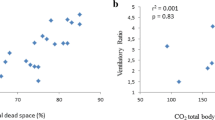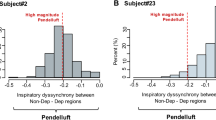Abstract
Oxidative stress plays an important role in chronic respiratory diseases where the use of non-invasive ventilation seems to reduce the oxidative damage. Data on acute respiratory failure are still lacking. The aim of the study is to investigate the interplay between oxidative stress and acute respiratory failure, and the role of non-invasive ventilation in this setting. We enrolled 60 patients suffering from acute respiratory failure (PaO2/FiO2 ratio <300): 30 consecutive patients treated with non-invasive ventilation and 30 consecutive patients treated with conventional oxygen therapy. Serum levels of soluble Nox2-derived peptide (sNOX2-dp), a marker of NADPH-oxidase activation, and 8-iso-PGF2α and H2O2, markers of oxidative stress, were evaluated at baseline and after 3 h of treatment. At baseline, higher values of sNOX2-dp, 8-iso-PGF2α and H2O2 are associated with lower values of PaO2/FiO2 ratio (p < 0.001). After 3 h, serum levels of sNOX2-dp, H2O2, and 8-iso-PGF2α significantly decrease in patients treated with non-invasive ventilation, but not in patients treated with conventional oxygen therapy. Delta changes of oxidative stress parameters correlate inversely with the delta changes of PaO2/FiO2 (R = −0.623, p < 0.001 for sNOX2-dp; R = −0.428, p < 0.001 for H2O2; R = −0.548, p < 0.001 for 8-iso-PGF2α). In the acute respiratory failure setting, treatment with non-invasive ventilation reduces the levels of oxidative stress in the first hours. This reduction is associated with an improvement of PaO2/FiO2 ratio as well as in a reduction of NADPH-oxidase activity.


Similar content being viewed by others
References
Holguin F (2013) Oxidative stress in airway diseases. Ann Am Thorac Soc 10(Suppl):S150–S157
Austin V, Crack PJ, Bozinovski S, Miller AA, Vlahos R (2016) COPD and stroke: are systemic inflammation and oxidative stress the missing links? Clin Sci (Lond) 130:1039–1050
Ryan S, Taylor CT, McNicholas WT (2005) Selective activation of inflammatory pathways by intermittent hypoxia in obstructive sleep apnea syndrome. Circulation 112:2660–2667
Oyama J, Yamamoto H, Maeda T, Ito A, Node K, Makino N (2012) Continuous positive airway pressure therapy improves vascular dysfunction and decreases oxidative stress in patients with the metabolic syndrome and obstructive sleep apnea syndrome. Clin Cardiol 35:231–236
Kirkham PA, Barnes PJ (2013) Oxidative stress in COPD. Chest 144:266–273
Rahman I (2005) The role of oxidative stress in the pathogenesis of COPD: implications for therapy. Treat Respir Med 4:175–200
Rahman I, Kinnula VL (2012) Strategies to decrease ongoing oxidant burden in chronic obstructive pulmonary disease. Expert Rev Clin Pharmacol 5:293–309
Hasegawa K, Tsugawa Y, Camargo CA Jr, Brown DF (2014) Frequent utilization of the emergency department for acute heart failure syndrome: a population-based study. Circ Cardiovasc Qual Outcomes 7:735–742
Suau SJ, DeBlieux PM (2016) Management of acute exacerbation of asthma and chronic obstructive pulmonary disease in the Emergency Department. Emerg Med Clin N Am 34:15–37
Frat JP, Thille AW, Mercat A et al (2015) High-flow oxygen through nasal cannula in acute hypoxemic respiratory failure. N Engl J Med 372:2185–2196
Davidson AC, Banham S, Elliott M et al (2016) BTS/ICS guideline for the ventilatory management of acute hypercapnic respiratory failure in adults. Thorax 71(Suppl 2):ii1–ii35
Ponikowski P, Voors AA, Anker SD et al (2016) 2016 ESC guidelines for the diagnosis and treatment of acute and chronic heart failure: the task force for the diagnosis and treatment of acute and chronic heart failure of the European Society of Cardiology (ESC) developed with the special contribution of the Heart Failure Association (HFA) of the ESC. Eur Heart J 37:2129–2200
O’Driscoll BR, Howard LS, Davison AG, British Thoracic S (2008) BTS guideline for emergency oxygen use in adult patients. Thorax 63(Suppl 6):vi1–vi68
Rabe KF, Hurd S, Anzueto A et al (2007) Global strategy for the diagnosis, management, and prevention of chronic obstructive pulmonary disease: GOLD executive summary. Am J Respir Crit Care Med 176:532–555
Pignatelli P, Cangemi R, Celestini A et al (2008) Tumour necrosis factor alpha upregulates platelet CD40L in patients with heart failure. Cardiovasc Res 78:515–522
Loffredo L, Carnevale R, Cangemi R et al (2013) NOX2 up-regulation is associated with artery dysfunction in patients with peripheral artery disease. Int J Cardiol 165:184–192
Cangemi R, Celestini A, Calvieri C et al (2012) Different behaviour of NOX2 activation in patients with paroxysmal/persistent or permanent atrial fibrillation. Heart 98:1063–1066
Perk J, De Backer G, Gohlke H et al (2012) European guidelines on cardiovascular disease prevention in clinical practice (version 2012). The fifth Joint Task Force of the European Society of Cardiology and Other Societies on Cardiovascular Disease Prevention in Clinical Practice (constituted by representatives of nine societies and by invited experts). Eur Heart J 33:1635–1701
Cangemi R, Calvieri C, Falcone M et al (2015) Relation of cardiac complications in the early phase of community-acquired pneumonia to long-term mortality and cardiovascular events. Am J Cardiol 116:647–651
Pignatelli P, Carnevale R, Cangemi R, Loffredo L, Sanguigni V, Stefanutti C, Basili S, Violi F (2010) Atorvastatin inhibits gp91phox circulating levels in patients with hypercholesterolemia. Arterioscler Thromb Vasc Biol 30:360–367
Cangemi R, Pignatelli P, Carnevale R et al (2012) Platelet isoprostane overproduction in diabetic patients treated with aspirin. Diabetes 61:1626–1632
Pastori D, Carnevale R, Bartimoccia S et al (2015) Does mediterranean diet reduce cardiovascular events and oxidative stress in atrial fibrillation? Antioxid Redox Signal 23:682–687
Gregoretti C, Pisani L, Cortegiani A, Ranieri VM (2015) Noninvasive ventilation in critically ill patients. Crit Care Clin 31:435–457
Allison MG, Winters ME (2016) Noninvasive ventilation for the emergency physician. Emerg Med Clin N Am 34:51–62
Vital FM, Ladeira MT, Atallah AN (2013) Non-invasive positive pressure ventilation (CPAP or bilevel NPPV) for cardiogenic pulmonary oedema. Cochrane Database Syst Rev 5:CD005351
Garcia-de-la-Asuncion J, Garcia-Del-Olmo E, Galan G et al (2016) Glutathione oxidation correlates with one-lung ventilation time and PO2/FiO2 ratio during pulmonary lobectomy. Redox Rep 21:219–226
Monneret D, Bonnefont-Rousselot D (2016) Paradoxical decrease in isoprostane and increase in superoxide dismutase following CPAP withdrawal in OSA. Eur Respir J 47:1012–1014
Morton B, Tang L, Gale R, Kelly M, Robertson H, Mogk M, Robin N, Welters I (2015) Performance of influenza-specific triage tools in an H1N1-positive cohort: P/F ratio better predicts the need for mechanical ventilation and critical care admission. Br J Anaesth 114:927–933
Santilli F, D’Ardes D, Davi G (2015) Oxidative stress in chronic vascular disease: from prediction to prevention. Vascul Pharmacol 74:23–37
Author information
Authors and Affiliations
Corresponding author
Ethics declarations
Conflict of interest
The authors declare that they have no conflict of interest.
Statement of human and animal rights
All procedures performed in this study involving human participants were in accordance with the ethical standard of the institutional and/or national research committee and with the 1964 Helsinki declaration and its later amendments.
Informed consent
Informed consent was obtained from all individual participants included in this study.
Additional information
Giuliano Bertazzoni and Pasquale Pignatelli shared joint senior authorship.
Rights and permissions
About this article
Cite this article
Garramone, A., Cangemi, R., Bresciani, E. et al. Early decrease of oxidative stress by non-invasive ventilation in patients with acute respiratory failure. Intern Emerg Med 13, 183–190 (2018). https://doi.org/10.1007/s11739-017-1750-5
Received:
Accepted:
Published:
Issue Date:
DOI: https://doi.org/10.1007/s11739-017-1750-5




